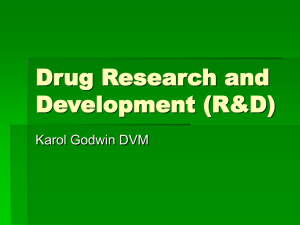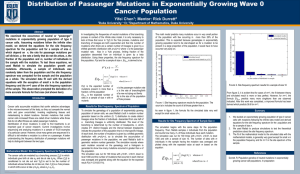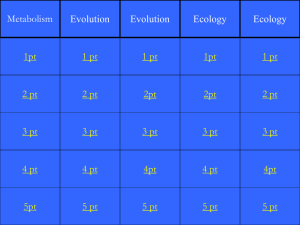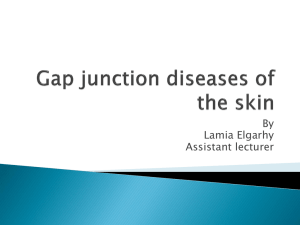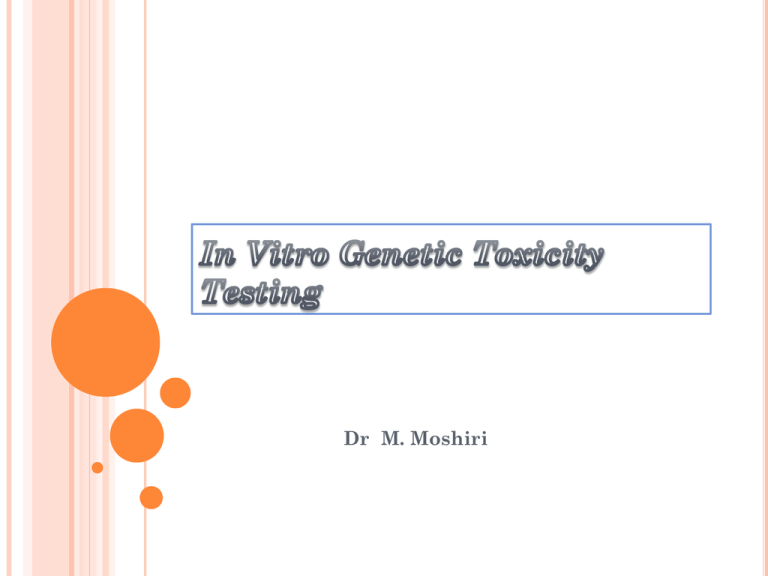
Dr M. Moshiri
In vitro genetic toxicity tests, concerned with the
genetic effects of toxic materials in vitro, are the
forerunner of all in vitro toxicity testing.
In contrast to in vitro tests measuring only toxic
effects, but often in cellular systems selected to
mimic target tissue and organ toxicity,
genotoxicity tests are selected for their
precision in assessing genetic effects in
surviving cells
About 5,000 diseases in humans are now known
to be caused by defective genes.
These inherited disorders cause 20% of all infant
mortalities
Half (50%) of all miscarriages
80% of all cases of mental retardation.
1)
2)
3)
Genetic toxicology test systems measure the outcome
of damage or alterations in DNA
If DNA is damaged, it may :
be correctly repaired with no genetic consequences
lead to cell death, again with no genetic
consequences
be replicated with the damage incorrectly repaired.
Only the third consequence leads to
mutations, DNA alterations propagated
through subsequent generations of cells or
individuals.
Genetic toxicology tests assessing DNA damage
and repair, such as SCE tests and tests for UDS
(the repair of DNA damage at times other than
the scheduled phase of the mitotic cycle, i.e., the
S-phase), are less frequently used for regulatory
submissions today because they provide only
indirect evidence of mutagenesis.
Instead, the harmonized testing approaches for
regulatory submissions, which will be
described, consist of tests for gene and
chromosomal mutations.
Gene mutations can be assessed in bacteria,
mammalian cells in culture, and whole
organisms
Gene mutations in bacteria
A base-pair substitution mutation =a single nucleotide is
changed a subsequent change in the complementary nucleotide on
the other strand of the DNA double helix.
Such mutations are deleterious when they alter a protein coding
sequence to
Conclude translation prematurely (a nonsense mutation)
incorporate a different amino acid (a missense mutation).
Gene mutations in bacteria
Frameshift mutations occur after the deletion or
insertion of one nucleotide, which then changes the
“reading frame” for the remainder of the gene, or
even for multiple genes.
Gene mutations in bacteria
Both base-pair substitution and frameshift mutations
are routinely measured in bacterial cells by
the cells’ acquisition of the capability of growth
in an environment containing a missing amino
acid
For these tests, a large number of bacteria is
examined to demonstrate significant increases
over spontaneous mutation frequencies.
A forward mutation occurs when a change takes place
in the native DNA
A reverse mutation occurs when a mutated cell is
returned to its initial phenotype.
The currently used bacterial tests are
reverse mutation assays.
Gene mutations in mammalian cells.
Generally forward mutations
Include base-pair substitution and frameshift
mutations.
Measurements of gene mutations in mammalian
cells reflect the greater complexity of mammalian
cells and chromosomes in comparison to those of
prokaryotes, and, thus, they more closely
approximate the genetic effects of chemicals in
rodent species and humans.
Gene mutations in mammalian cells.
In contrast to bacteria, mammalian cells are
essentially diploid (2n, with two copies of each
chromosome).
Mammalian chromosomes contain nonfunctional
( noncoding), as well as functional(coding)
sequences.
Usually two copies of each gene exist (one on
each chromosome)
One (dominant) form of the gene may be
expressed while the other (recessive) gene
remains unexpressed, unless both copies are
recessive.
Gene mutations in mammalian cells.
Homozygous = both copies of the gene are the
same
Heterozygous= the copies are different
Hemizygous = only one chromosome is present to
carry the trait.
Hemizygous traits are found on the X
chromosome in mammals because males
have only one X chromosome, and only one X
chromosome is expressed in female cells.
Gene mutations in vivo
In spite of the early promise of transgenic
mutagenesis systems, they have been found to
lack sensitivity and to be capable of detecting
only a few of the chemicals known to be rodent
carcinogens.
Therefore, such tests are currently identified as
optional, but not required, systems for regulatory
submissions, and no universally accepted and
routinely used test system exists for assessing
gene mutations in vivo.
Chromosomal Mutations
Chromosomal mutations are large-scale numerical or structural
alterations in eukaryotic chromosomes that may affect the
expression of numerous genes with gross effects, or be lethal to
affected cells .
Including
Small and large deletions (visualized as breaks)
Translocations (exchanges)
Nondisjunction (aneuploidy)
Mitotic recombination
Chromosomal abnormalities are associated with neoplasia,
spontaneous abortion, congenital malformation, and infertility, which
occur in approximately 0.6% of live births in humans.
It has been estimated that up to 40% of spontaneous abortuses have
chromosomal defects and essentially all tumors harbor
chromosomal mutations.
Chromosomal Mutations
Chromosomal mutations in mammalian cells.
The L5178Y mouse lymphoma assay is routinely used
Because it is the most extensively characterized of the
several assays.
Chromosomal Mutations
Chromosomal mutations in mammalian cells.
L5178Y mouse lymphoma assay
the L5178YTK+/- mouse lymphoma-TK assay detects the
mutations at the thymidine kinase locus caused by base
pair changes, frameshift and small deletions.
Mutant cells, deficient in TK due to the forward mutation
in the TK locus (from TK+ to TK-), are resistant to the
cytotoxic effect of pyrimidine analogues such as
trifluorothymidine (TFT).
The mutagenicity of the test agents is indicated by the
increase in the number of mutants after treatment.
Chromosomal Mutations
Chromosomal aberrations
In vitro and in vivo
In contrast to the described assays, which assess gene
and chromosomal mutations at only one or a few genes,
in millions of cells per treatment, the in vitro and in vivo
assays for chromosomal aberrations assess mutagenic
events in multiple genes, but usually for no more than
200 cells per culture, or for up to 100 cells per animal.
Chromosomal Mutations
Chromosomal aberrations
In vitro and in vivo.
Chromosome breakage, necessary for chromosomal
rearrangements, is the classic endpoint in chromosomal
aberration assays.
To visualize chromosomes and chromosomal aberrations
with a light microscope
after in vitro or in vivo treatment with a chemical
cells are arrested in metaphase
treated with a hypotonic solution to swell the
chromosomes
fixed ,transferred to microscope slides, and stained
Chromosomal Mutations
Chromosomal aberrations
In vitro and in vivo.
The first metaphase (M) after chemical exposure, M1,
is the time when the greatest number of
chromosomally damaged cells may be observed,
the extent of damage declines rapidly after M1
intherphse
prophse
Metaphse
Anaphse
Early telophse
Late telophse
Chromosomal Mutations
Chromosomal aberrations
In vitro and in vivo.
When the chromosomes of diploid somatic cells are replicated, each
chromosome then consists of two (sister) chromatids separating at
mitosis to become the chromosomes of the daughter cells.
If chromosomal mutations occur before replication (DNA
synthesis), both chromatids will be affected.
This damage will be visualized as chromosomal breaks
(deletions) and exchanges (translocations).
Chromosomal Mutations
Chromosomal aberrations
In vitro and in vivo.
If these mutations occur
during replication (the most
sensitive stage), or after
replication, the damage is
visualized as chromatid
breaks and exchanges.
Chromosomal Mutations
Chromosomal aberrations
In vitro and in vivo.
Hence, by enumerating chromatid and chromosome
breaks and exchanges, an index can be obtained of the
time that the damage occurred.
Very large deletions are tolerated only if they do not
incapacitate essential genes.
Chromosomal Mutations
Chromosomal aberrations
In vitro and in vivo.
Although not currently used in cytogenetic testing for
regulatory submissions, fluorescence in situ hybridization
(FISH) staining techniques have been recently developed
for human and mouse chromosomes, in which each
chromosome can be differentially stained, revealing
chromosomal rearrangements not apparent with
conventional staining techniques
When FISH staining is translated from a research
approach to a testing protocol, it may be possible to reduce
the number of chromosomes to be analyzed and, hence,
the time for chromosomal aberration tests.
Chromosomal Mutations
Micronuclei:
Micronuclei result when nuclear membranes form around
broken pieces of chromosomes or around chromosomes
failing to separate at cell division.
Therefore, micronucleus tests measure
chromosome breakage, the
classic endpoint for chromosomal
aberration assays
aneuploidy, the loss or gain of a
chromosome or a chromosome
segment.
Chromosomal Mutations
Micronuclei:
In vitro micronucleus tests are currently
under development in a number of
laboratories as a less subjective and more
economical alternative to in vitro
chromosomal aberration tests.
For these approaches, cytochalasin B is
used to arrest cell division (cytokinesis) but
not nuclear division, and up to 1,000
binucleate cells are examined for the
presence or absence of micronuclei.
because the in vitro micronucleus tests have
yet to be validated and shown to be at least as
effective as tests for chromosomal
aberrations in vitro, none is currently
recommended for regulatory Submissions.
Chromosomal Mutations
Micronuclei:
In vivo micronucleus tests are justified for regulatory submissions
for assessing chromosomal breakage and aneuploidy in an
environment including in vitro metabolic reactions.
Micronuclei are readily observed microscopically in stained
preparations of (otherwise anucleate) polychromatic
erythrocytes (PCEs) from the bone marrow of rats or mice or
from the peripheral blood of mice; the latter because, in mice,
the spleen does not remove micronucleated cells from the blood.
With appropriate staining techniques, the PCEs can be
differentiated from the more mature normochromatic
erythrocytes (NCEs) because the PCEs still contain RNA, which
has been lost by the NCEs.
For example, with Giemsa staining, the PCEs are blue and the
NCEs are salmon pink or red.
Chromosomal Mutations
Micronuclei:
Peripheral blood erythrocytes can be obtained for
micronucleus evaluations
without sacrificing the animal,
a greater number of cells must be evaluated
because the newly formed erythrocytes (PCEs,
the cells of interest) are diluted in the
population of preexisting erythrocytes.
Bone marrow cells
give amore informative index of toxicity
are routinely used for the micronucleus test.
Current OECD SIDS and ICH regulatory guidance
has identified the following five basic genetic
toxicology approaches
1) A test for bacterial reverse gene mutations
2) the L5178Y mouse lymphoma cell assay for
gene and chromosomal mutations
3) An in vitro chromosomal aberration test, and
either
4) An in vivo chromosomal aberration test or
5) An in vivo micronucleus test,
TSCA (Toxic Substances Control Act) regulatory
guidance has identified all but the in vitro
chromosomal aberration test.
To establish that a chemical is negative
in vitro tests must be conducted in the absence and presence of
exogenous metabolic activation
Positive and negative controls must be within historical ranges for
the testing laboratory
Testing must be conducted to a level at which toxicity or
precipitation is observed or to a level for which higher
concentrations would not yield biologically relevant results.
The latter two requirements are also applicable for in vivo tests.
In
addition, the animals must be maintained
under conditions minimizing the influence
of environmental variables, and
bioavailability must be considered when
selecting the route of administration.
It should also be noted that, although some
prior testing guidelines specified that test
results should be reproducible in
independent experiments, under current
guidelines, no requirement exists for
repeating an appropriately conducted test
yielding clearly positive results.
The most extensive testing for gene mutations is in bacteria, particularly
using reverse mutation in Salmonella typhimurium and Escberichia coli.
Therefore, bacterial reverse mutation assays are considered by many
researchers to be the cornerstone of genetic toxicology testing.
Advantages
relative ease of performance
Economy
Efficiency
the ability to identify specific DNA damage that is induced, e.g.,
frameshift or base-pair substitution mutations
Bacterial tests can also provide information on the mode of action of the
test chemical, because the bacterial strains used vary in their
responsiveness to different chemical classes.
Many of the tester strains have features making them more sensitive for
the detection of mutations, including
responsive DNA sequences at the reversion sites
increased cell permeability to large molecules
the elimination of DNA repair systems or the enhancement of
error-prone DNA repair processes.
The S. typhimurium strains routinely used were
designed for sensitivity in detecting gene mutations
reverting the bacteria to histidine independence
the Salmonella strains are histidine auxotrophs by
virtue of mutations in the histidine operon.
The E. coli WP2 uvrA strains recommended for initial
tests are tryptophan auxotrophs by virtue of a base-pair
substitution mutation in the tryptophan operon.
When these histidine- or tryptophan-dependent cells
are grown on minimal medium agar plates containing
a trace of histidine or tryptophan, only those cells
reverting to histidine or tryptophan independence are
able to form colonies.
In addition to the histidine
and tryptophan operons, most
of the indicator strains carry a
deletion covering genes
involved in the synthesis of
the vitamin biotin (bio), and
all carry the rfa mutation
leading to a defective
lipopolysaccharide coat and
making the strains more
permeable to many large
molecules.
The strains also carry the uvrB
mutation, which results in
impaired repair of ultraviolet
(UV)-induced DNA damage and
renders the bacteria unable to
use accurate excision repair
to remove certain chemically
or physically damaged DNA,
thereby enhancing the strains’
sensitivity to some mutagenic
agents.
In bacterial reverse mutation testing, usually one
strain is used for a preliminary concentration
range-finding assay, and then mutagenesis assays
are conducted with five strains. The strains
recommended by the OECD guidelines are:
1. S. typhimurium TA1535
2.
S. typhimurium TA1537 or TA97 or TA97a
3.
S. typhimurium TA98
4.
S. typhimurium TA100 (histidine independence
by base-pair mutagens)
5.
E. coli WP2 uvrA or E. coli WP2 uvrA (pKM101)
or S. typhimurium TA102
In the standard plate incorporation protocol
the test material, bacteria, and either a metabolic
activation mixture [9, 000-g postmitochondrial supernatant
(S9)] or a buffer are added to liquid top agar
Agar in a disposable glass tube, which is held at 45°C in a
heating block while the components are added, then
mixed, and the mixture is immediately poured on a plate of
bottom agar.
After the agar gels, the bacteria are incubated, at 37°C, for
48–72 hours; then, the resulting colonies are counted.
In a typical mutagenesis assay with and without metabolic
activation, each of the five strains of bacteria is exposed to the
solvent control (with six cultures per strain and activation
condition), and to five concentrations of the test chemical (with
three cultures per concentration, strain, and activation
condition), and to the appropriate positive controls for that
strain (with three cultures per activation condition).
This process yields a total of 240 bacterial plates and additional
plates used to check the sterility of the components.
The preincubation modification
this method is used for materials that may be
poorly detected in the plate incorporation
assay, including
short chain aliphatic nitrosamines
divalent metals
aldehydes
azo-dyes and diazo compounds
pyrollizidine alkaloids
alkyl compounds
nitro compounds.
In this protocol, the test material, bacteria, and S9
mixture (when used) are incubated for 20–30 minutes
at 37°C before top agar is added, mixed, and the
mixture is poured on a plate of bottom agar.
For an acceptable assay, the test chemical should be
tested to a toxic level,
as evidenced by a reduction in colonies or a
reduced background lawn
to a level at which precipitated test material
precludes visualization of the colonies
or
to 5 mg or 5 μl/plate
whichever is lower.
To evaluate a result as positive requires
a concentration-related
Or
a reproducible increase in the number of
revertant colonies per plate for at least one
strain with or without activation.
The L5178Y mouse lymphoma assay
measures gene and chromosomal forward
mutations at the tk locus, tk+/−−−>tk−/−/−
As indicated in the recent EPA Gene-Tox
review of published results for over 600
chemicals tested in this assay ,
When used with appropriate protocols and
evaluation criteria, the mouse lymphoma
assay yields results at least 95%
concordant with the outcome of the rodent
carcinogenesis bioassay.
http://www.fda.gov/Food/GuidanceComplianceRegulatoryInformation/GuidanceDocu
ments/FoodIngredientsandPackaging/Redbook/ucm078336.htm
More recently, the L5178Y mouse lymphoma cells were
found to harbor gene mutations p53 ( in the mouse, is found on the
same chromosome as tk.)
The p53 tumor suppressor gene is considered to be the
“guardian of the genome” because its function is to delay
the cell-cycle progression of cells that have acquired
chromosomal mutations until the damage has been
repaired.
Thus, the presence of mutant p53 in the mouse
lymphoma cells renders the assay more similar to
mutation assays in repair-deficient bacteria.
this finding is not only consistent with the sensitivity of this
assay for detecting chromosomal mutations, but it
enhances the relevance of the assay for predicting
carcinogenicity, as mutant p53 is found in over 50% of
human tumors.
L5178Y mouse lymphoma cells grow in suspension culture with
a relatively short cell generation time, 9–10 hours.
A few days before use in an assay, a culture is “cleansed” of
preexisting spontaneous tk −/− mutants by growing the cells for
about 24 hours in medium containing methotrexate.
After the cells have recovered from cleansing, they are exposed
to a series of concentrations of the test chemical, usually for 4
hours, in the absence and presence of metabolic activation.
Testing under nonphysiologic conditions must be avoided in this
assay and in other in vitro mammalian cell assays, as acidic pH
shifts, to ≤6.5, and high salt concentrations have been shown to
produce physiologically irrelevant positive results.
Conversely, if the pH of the medium used to culture the cells is
≥7.5, cell growth in suspension culture may be depressed, and
small colony mutants, in particular, may not be detected
Because chromosomal mutations are
usually associated with slower growth
rates and because the induction of both
gene and chromosomal mutations are
associated with cytotoxicity,
A chemical cannot be considered to be
nongenotoxic in this assay unless
testing is performed to concentrations
producing significant cytotoxicity,
Cytotoxicity should be determined for each individual test and control culture.
For the soft agar version of the MLA, this has generally been done using the relative
total growth (RTG)
This measure includes the relative growth in suspension during the expression
time and the relative cloning efficiency at the time that mutants are selected.
The microwell version of the assay was developed using the relative survival (RS) as
the cytotoxicity measure.
The RS is determined by the relative plating efficiency of each culture when
plated immediately after the exposure period
The RTG and the RS are different measures of cytotoxicity and, although there
is no real justification that one measure is superior to the other, it is important
that the same measure of cytotoxicity be used for both versions of the assay.
Because the RS is not normally measured in the soft agar version of the assay and the
RTG is measured in both versions, it is recommended that the RTG be used as the
standard measure of cytotoxicity.
On the other hand, responses observed only at extreme cytoxicity (<10% RTG) are
considered to be biologically irrelevant.
Therefore, exposure concentrations for each assay are selected, based on the results
of a preliminary range-finding experiment,
to span a range of anticipated survival from nontoxic or weakly toxic to 10–
20% RTG, with the concentrations selected to emphasize the lower RTG
values.
For relatively noncytotoxic chemicals, the maximum concentration should be
5 μl/ ml,
5 mg/ml,
10 mM,
A concentration evidencing insolubility
whichever is lower.
Procedure
1. Treatment with test substance
Cells, growing in log phase, should be exposed to the test
substance both with and without metabolic activation. Exposure
should be for a suitable period of time (generally 3-4 hrs is used).
2. Expression time and measurement of mutant frequency
At the end of the exposure period, cells are washed and cultured to
allow for the expression of the mutant phenotype (in suspension
culture for a 2-day expression period)
the cells are cloned to measure mutagenesis and survival
Two methods are currently used for cloning :
cloned in culture dishes in a medium containing sufficient soft agar to
immobilize the cells (2 WEEK)
b) cloning the cells without agar in microwell plates(10-12 days)
a)
3. Mutant Colony Sizing
Chromosomal Aberrations: In Vitro
In vitro chromosomal aberration assays for regulatory submissions are routinely conducted in the absence
and presence of exogenous metabolic activation and may use
a variety of established cell lines
cell strains,
primary cell cultures
• selected on the basis of factors such as
growth ability in culture
stability of the karyotype
chromosome number
chromosome diversity
spontaneous frequency of chromosome aberrations.
The most frequently used cells are Chinese hamster fibroblasts (either CHO or Chinese hamster lung
(CHL) cells) or human or rat lymphocytes stimulated to divide synchronously in vitro.
Established cell cultures present the advantages of minimal variability among experiments
Chromosomal Aberrations: In Vitro
The cells are propagated from stock cultures and seeded in a culture
medium at a density such that the cultures will not reach confluency before
the time of harvest, which should be ~1.5 hours after the addition of a
mitotic spindle inhibitor (Colcemid or colchicine).
Human lymphocyte cultures are used because of
their perceived relevance to the human condition
to presenting the advantage of synchronous cell division.
Variability in mitogenic response can be minimized by using cultures of
rat lymphocytes.
Chromosomal Aberrations: In Vitro
The lymphocytes are usually obtained from whole blood from healthy
(human or rodent) subjects, treated with heparin (an anticoagulant), and
stimulated to divide with a mitogen (e.g., phytohemagglutinin).
After a prolonged G1 stage, the cells enter S-phase, which should be the
time of addition of the test chemical to the cells.
chemical exposure is initiated at 48 hours
a mitotic spindle inhibitor is added at 70.5 hours
cells in metaphase are harvested at 72 hours.
After the cells are harvested, they are treated with a hypotonic solution
to swell the chromosomes fixed, dropped onto prelabeled slides
The chromosomes are stained cover slips are attached to permit
microscopic analysis with oil immersion (100X) objectives.
Chromosomal Aberrations: In Vitro
At least three concentrations are analyzed that are
selected based on a preliminary evaluation of
uncoded slides.
Chromosomal Aberrations: In Vitro
Among the criteria to be considered when determining the highest concentration to
be tested for chromosomal aberrations are
cytotoxicity
Solubility
and changes in osmolality or pH to ensure that exposure conditions will be in a
physiologically relevant range
As a general rule-of-thumb, to ensure that
a sufficient number of mitotic cells for analyses exist
mitotic indices need not be depressed more than 50%.
For relatively noncytotoxic chemicals, the maximum concentration should be
5μl/ml
5 mg/ml
10 mM,
whichever is lowest.
For relatively insoluble chemicals, OECD guidelines advise
testing one or more than one concentration in the insoluble range
as long as a precipitate does not interfere with the analysis.
Chromosomal Aberrations: In Vitro
OECD guidelines recommend that
The cells should be exposed to the test chemical
both with and without metabolic activation for 3–
6 hours
Sampled at a time equivalent to about 1.5 times
the normal cell cycle after the beginning of
treatment
Chromosomal Aberrations: In Vitro
If the result is unambiguously positive, no further testing
is needed.
If the chemical yields negative results with and without
activation, a second experiment without metabolic
activation is recommended with continuous treatment
until a sampling time equivalent to about 1.5 times the
normal cell cycle after the beginning of treatment.
The ICH guidelines go one step further and specify that if
the second experiment is also negative, a third
experiment without metabolic activation is needed, with
a continuous 24-hour treatment time
In vivo tests for chromosomal effects for regulatory
submissions consist of the in vivo chromosomal
aberration test and the micronucleus test.
They are routinely conducted using bone marrow cells
from rodents, e.g., mice or rats because
the B.M. is highly vascularized
B.M. contains a population of rapidly dividing
cells
Cells can be readily isolated and processed.
However, the micronucleus test can also be
conducted with sampling of cells from the
peripheral blood that were exposed to the test
chemical while in the B.M. because the target cells
are exposed to the products of in vivo metabolism
under physiologic conditions
These tests are particularly useful if positive results
have been obtained with an in vitro test for
chromosomal effects.
They are not appropriate tests if evidence exists
that the test substance, or a reactive metabolite
will not reach the bone marrow.
In this case, other tests may be required.
Dosing is routinely accomplished by intraperitoneal
injection or gavage, but subcutaneous and
inhalation exposures are also used, if justified.
The maximum dose level required for relatively
nontoxic chemicals is 2,000-mg/kg body weight
The maximum volume administered by injection or
gavage should not exceed 2-ml/100-g body weight.
If available pharmacokinetic or toxicity data
demonstrate that no substantial differences exist
between sexes testing in a single sex, preferably
males, is sufficient.
If human exposure may be sex-specific, the test
should be performed in animals of the appropriate
sex.
.
Preliminary dose range-finding tests for toxicity are
necessary, sometimes using an evaluation :
of mitotic indices for the chromosomal aberration
test
enumerating PCE ratios for the micronucleus test,
High dose that least five analyzable animals per sex are
together, with a sufficient number of cells for analysis.
This dose is often significantly lower than is the LD50
defined in acute toxicology testing
Positive and negative (solvent/vehicle) controls are used for
each sex and, except for treatment, the positive and
negative control animals should be handled in the same
way as the treated animals.
The positive control may be administered by a different
route than is the one used for the test chemical, and only
one sampling time is required.
The negative control is administered by the same route as
the test chemical, and negative controls are used for each
sampling time
• A minimum of three dose levels plus the
appropriate controls are required
• The highest dose is defined as
2,000-mg/kg body weight
Or
the dose-producing signs of toxicity
Or
A dose that produces some indication
of toxicity in the bone marrow (e.g., a
greater than 50% reduction in the
mitotic index)
Chemicals are preferably administered as a single
treatment
Samples are taken at two separate times after treatment
The first sampling interval is 1.5 times the
normal cell-cycle length therefore, the first
samples are obtained 12–18 hours after
treatment.
A second sampling time, 24 hours after the first
the time required for uptake and
metabolism of the test chemical as
well as its effect on cell-cycle kinetics
Only the highest dose is used for the
second time.
The animals are injected IP
(1.5–2 hours before sampling)
Colcemid or colchicine
sacrificed, cells are removed
from the bone marrow
treated with a hypotonic
solution, and fixed; then, slides
are prepared, stained,
• Mitotic indices are obtained based on at
least 1,000 cells per animal, and at least
100 cells per animal should be analyzed
for chromosomal aberrations, unless a
high number of aberrations is observed.
• Criteria for a positive response include
a dose-related increase in the number
of cells with chromosomal aberrations
a clear increase in the number of cells
with aberrations in a single dose group
at a single sampling time.
• The highest dose is defined as
2,000-mg/kg body weight
The dose-producing signs of toxicity,
such that higher dose levels.
A dose producing some indication of
toxicity in the bone marrow (e.g., a
reduction in the percentage of PCEs in
the bone marrow).
• The test may be performed in two ways
1) Animals are treated with the test chemical once
1-1) Samples of bone marrow cells are obtained at least
twice, with the first samples obtained no earlier than 24
hours after treatment and the last samples no later
than 48 hours after treatment.
1-2) Samples of peripheral blood are obtained at least
twice, with the first samples obtained no earlier than
hours after treatment and the last samples no later
than 72 hours after treatment.
1-3) Three dose levels, plus negative and positive controls
are required for the first sampling time, but only the
highest dose may be required for the second sampling
time.
2) The animals are treated on each of 2 or more
consecutive days to achieve steady-state
kinetics,
2-1) samples are obtained once, between 18 and
24 hours after the final treatment for the bone
marrow
2-2) samples are obtained once between 36 and
48 hours after treatment for the peripheral blood.
• Bone marrow cells are usually obtained from
the femurs or tibias immediately after sacrifice,
• peripheral blood is routinely obtained from the
midventral tail vein and
• The proportion of PCEs
(polychromatic erythrocytes ) among
total erythrocytes (PCEs plus
NCEs), which is a measure of
toxicity, is obtained for at least 200
bone marrow erythrocytes, or for
at least 2,000 erythrocytes from the
peripheral blood.
• Then at least 2,000 PCEs per
animal are evaluated to obtain the
percentage with micronuclei
• Criteria for a positive response include
a dose-related increase in the number
of PCEs with micronuclei
a clear increase in the number of
micronucleated PCEs at a single
sampling time
Gene mutations in mammalian cells.
Gene mutations are routinely measured in mammalian
cells after the mutant cells’ acquisition of the capability of
growth in the presence of a selective agent, an otherwise
toxic drug that can no longer be used by the mutated cell.
As for the bacterial assays, a large number of cells is
examined to demonstrate significant increases over
spontaneous mutation frequencies.
However, in mammalian cell gene mutation assays, the
chemical exposure step must be followed by an expression
period, during which mutant (and nonmutant) cells
increase in number and the nonmutant protein (enzyme)
present in the mutated cells and the RNA coding for that
protein are depleted.
Only then can the selective agent be added to permit only
the mutated cells to grow and form colonies.


